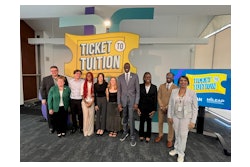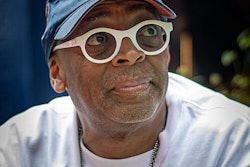The view of Norfolk State University’s 120-acre campus, as seen
from the ceiling-to-floor window in the office of the president, is
deceptive. In the foreground, sit the neatly, manicured lawn and
sparkling aquamarine pool of the school’s red-brick presidential
residence. The scene reveals nothing to suggest this is an institution
struggling to recover from a multimillion-dollar fiscal deficit.
Dr. Marie Valentine McDemmond moved into this cozy fifth-floor
presidential office on July 1, 1997, becoming not only the first woman
to lead this sixty-three-year-old university, but the first to become
president of a public four-year university in the Commonwealth of
Virginia. Little did McDemmond know when she began her new job that the
verdant vista from her office window would become a thorny symbol of
the perception problems she, and the university, must now overcome.
Details about Norfolk State’s financial woes began to make
headlines locally and nationally within months of McDemmond’s arrival.
She was prompt to implement a cost-cutting strategy that included the
unpopular decisions of laying off 116 employees and increasing student
fees by 27 percent. Then, this past July, McDemmond — who perhaps
ironically, has built a career as a prudent higher education fiscal
manager — found herself in the awkward position of having to explain
to Virginians why the house she lives in was renovated to the tune of
more than $200,000 at a time when the university was facing a $4
million deficit.
In her own defense, McDemmond maintains that the university’s
fiscal difficulties were incurred prior to her taking office. Her
predecessor, Dr. Harrison B. Wilson, is a well-heeled,
politically-connected, mammoth of a man whose twenty-two-year imprint
is found in facilities, programs, and systems throughout the NSU
campus. He has rebuked McDemmond’s assaults on his legacy and continues
to linger at the university as a president emeritus with an on-campus
office and a three-course teaching load in the School of Education.
Despite the obvious tensions that exist in such a charged
environment, McDemmond appears remarkably confident and optimistic
about the future of NSU as well as in her own ability to lead the
university out of this crisis. A graduate of Xavier University of
Louisiana, and the University of New Orleans, where she earned her
bachelor’s and master’s degrees, respectively, she completed her
doctorate in higher education administration and finance from the
University of Massachusetts-Amherst. Her thirty-year career has
included experiences as a professor of education, and as a senior
administrator at Emory University, the University of
Massachusetts-Amherst, and Atlanta University, among others. Earlier
this year she was named to a three-year term as a Senior Scholar by the
National Association for Women in Education (NAWE).
Black Issues Executive Editor Cheryl D. Fields spoke to McDemmond
last month about the NSU deficit and house controversy, her long-range
plans for the university, and her views on the particular challenges
African American women face as they move into presidential positions at
the nation’s historically Black colleges and universities. The
following is excerpted from that conversation:
Were you aware of Norfolk State University’s financial situation before you came here? And if not, why?
I was named [president] in December of 1996, and I was not sent the financial statements until around January [1997].
The first board meeting that I attended was a retreat in
Williamsburg in February 1997, before I started — I started in July
1997. One of the board members at that time asked if there was a
deficit in athletics, and the answer was “No.” So I questioned one or
two people, but I didn’t make a big push of it.
I think the first time that I mentioned more about the deficit
situation was at the April board meeting. Phil Walzer’s article said
that I had called it “one of the signals” or “a red flag” or something.
What I saw was a financial statement that showed auxiliary deficits.
And the auxiliary deficits were in athletics, housing, and about four
or five others. And what I was more concerned about than even the
individual deficits was the trend on using so much cash out of the
auxiliaries, because the fund balance — we call it “eating the fund
balance” — was being reduced substantially in the auxiliaries.
Now, that did not tell me anything about the state side of the
house and I did not see any of the state deficit. In fact, when I
looked at the financial statement through June 30, 1997, there was a
fund balance which was positive. In the state side, a little under
half-a-million dollars. So, … we did some cash flow projections in
the mid to late fall. And the cash flow projections gave me some
problems, some reason to be concerned because I didn’t see the cash
coming in.
So when I went back and talked to some of the financial people at
the university control level, they said to me, “Well, we were
transferring money from the auxiliaries to the state fund, and that had
been going on for five years.”
Is that a common practice?
Well, I had not seen it before. I believe it had been cited in one
of Norfolk State’s audit reports about five years ago. But that I could
not see until we started digging — and by that time, we were into our
SACSCC [Southern Association of Colleges and Schools] accreditation.
About nineteen different things were going on at the same time. So I
said, well, we’ll wait until after the SACSCC accreditation and we’ll
bring in Peat Marwick [& Associates], because I want them to look
at my figures and verify them before I raised this with the state.
I had already alerted the board that there were some problems. When
I had Peat Marwick verify the figures, then I sat down with the board
and explained everything to them, walked them through the scenario,
then I went to the state. This was already into the first week in
December, now.
Then, after the state, I had a meeting in January — what you call
open assembly for the spring semester — and I walked everyone here
through the financial problems. That open assembly is mainly for deans,
directors, and all faculty members…. I asked the state for the loan
in December, and so the open assembly was [around] January 6.
So, that’s a long answer to tell you I couldn’t see the deficits on
the state side because auxiliary money is like transferring from one of
your checking accounts to the other. So when you think you only have a
deficit over here because you transferred so much that you ran out of
money, you wind up with a deficit on both sides.
When you realized the magnitude of what you were facing, what was your internal reaction?
My internal reaction was something like, “Oh, my goodness. This is a little more complicated to get out of.”
With an auxiliary deficit alone, there could have been other ways
[to manage the deficit]…. But looking at your core business, your
state side, your academic side also running a deficit, then it was a
little more complicated — a lot more complicated.
Some people charge that you weren’t very diplomatic in your
criticism of your predecessor, Dr. Harrison B. Wilson. Do you think
that’s fair?
Well, let me start this way, I believe in participatory management,
and I believe in the concept of shared leadership. When you are running
a university today, be it an HBCU [historically Black college and
university] or not, you need to involve many people in the
decision-making process, in the input into decisions. I could not hide
the deficit. Some people say I shouldn’t have talked about it. I felt
it was better to explain to everyone about the finances.
This has been a fairly closed [institution, in that details about]
finances have not been provided to many people in the institution
before. I have always, in my almost thirty years in higher ed, believed
that the finances are to be known by everybody in the institution,
because … you have to have an open book.
I think the former administration, particularly President Wilson,
has done an outstanding job here at the university, to build the
facilities. We have everything. We have a lot of financial issues that
we have to attend to now, though.
I don’t want anything to be seen as me against them. Unfortunately,
that’s the way a lot of people have been taking it. I’m concerned that
HBCUs in particular put a lot of the strife behind us and are able to
go forward, because there are such wonderful things going on here….
I think we have to be very concerned that we put our best foot
forward. Even though the deficit was something very unfortunate that I
had to experience, I was able to make the best of it, or the university
the best of it, really, to see how we could realign ourselves and
refocus ourselves, even with reductions in staff — because we have one
goal and that is the goal of student success….
Talk to me about this house situation. Why didn’t you stop the improvements on the house?
All the renovations were done before I moved in. I moved in June
16, 1997. I didn’t know about the state deficit, as I said, until late
fall of 1997. So they were already done, and they were done by people
who were saying there were no money problems, but also were signing all
those requisitions. I was not even acting president, I was not in
charge.
Does the fact that you’re a woman in this position present additional challenges for you?
Yes, it does. I think women in leadership positions across this
county … have to work sometimes a lot harder in order to succeed. And
I think that’s still a fact in America today.
At an HBCU, African American women at the top are also in that same
bind. We are not often seen as the ones who should be the leaders. The
statistics bear me out, if nothing else. The numbers seem to tell me
everything. If the numbers were slightly different, maybe that wouldn’t
be the case.
It’s been very difficult for African American women to succeed in
leadership positions in our HBCUs. For me, that’s unfortunate, because
at Norfolk State and all of our HBCUs, there are more women in our
student bodies than men. Sixty-four percent [of the students are] women
here at Norfolk State. And I think that’s the case across the board at
HBCUs. Not to have women in the top leadership, I think, does not
provide good role modeling for our female students.
Give me a concrete example of the kinds of things that you are talking about.
Well, it goes all the way from when I [answer the phone and] say
“Dr. McDemmond,” [and] they say, “Well, is he there?” You know, [it’s]
little things like that, to people in and outside of the institution
wanting to have you provide a little more explanation for some things.
Or asking for your reasoning a little more than they would before.
My management style is very different than a male’s. And I think
statistics are showing these days that women’s leadership and women’s
management styles are, in fact, more conducive for the management of
the future. So I think we have an advantage in a lot of ways.
Tell me how.
Well, we are much more participatory. The team approach to
management is much more a woman’s leadership style according to the
research at the Harvard Business School and other places.
So I think we are trying our best, as women, to move up in higher
ed administration. I taught sixteen years of my life at Bryn Mawr and
Wellesley colleges in Project HERS ….
[Women are] really not a threat to men. I think we have complementary administrative and management styles.
In terms of the future of HBCUs and the participatory leadership
that women can bring to these institutions, what would you say to your
peers about what needs to change about the culture of these
institutions in order for them to reach their full potential?
HBCUs have a unique culture, and I’m a product of an HBCU — from
my days on campus, to being vice president at Atlanta University. We
tend to be very insular. We haven’t changed very much with the times.
That’s one of the things that we’re looking to do here at Norfolk
State, looking at more non-traditional delivery modes — looking at
Web-based instruction, looking at bringing in certifications in areas
where we haven’t done certification kinds of programs….
We’re looking at a number of partnerships with business and
industry trying to produce what the Commonwealth of Virginia and this
region needs for jobs in the future.
Those are the kinds of things that we have to look at. We have to
do demographic surveys and see how we’re going to meet the needs of our
market. As that changes, we have to change. So some of the climate in
the HBCUs has to adapt to those economic changes.
How about the financial management of these institutions?
Financial management is a critical component of higher education. I
think a lot of people would say that I tend to keep my eyes very
[focused] on the money, and maybe less on the academics. But really,
you can’t do anything without the financial wherewithal. You can have
the best academic or student-support program, and all that has to be
said is that we don’t have the money to do it. What winds up suffering
will be your students and your survivability.
So I see financial management as one of the key components to bettering our HBCUs and all of higher education.
The National Cost Commission, Graham Report, all of those are
speaking to demystifying financial management. I used to teach that at
a seminar about twelve years ago, “Demystifying Financial Management.”
… One of the things [HBCUs] don’t do is involve our managers. We have
an institution, all of us, that has layers of management — and I don’t
mean that in a bad way, [but] in a good way. We have anywhere from
directors to department chairs [and] deans, and we must involve them in
the financial and administrative management in our institutions.
What about the Norfolk State deficit business? What are you all going to do about this?
Well, what we did was we worked with Peat Marwick to define a
six-year repayment plan for all the deficits. So that six-year plan,
we’re monitoring. And it will involve, and did involve, raising the
fees — unfortunately for the students. But only by $127.00 a semester.
And we have quite a beautiful stadium, and we have twenty years of debt service on this. So we have to pay that off.
Given all the controversy that’s been swirling around you, what do you see as your biggest challenge in the next year?
I guess to be able to put [behind us] the … controversy over an
expenditure that I really didn’t have any major involvement in. Yes, I
picked out furniture because they asked me what color of this I wanted,
and what color of that. But [we must] put that behind us and to think
about Norfolk State and its students. We have great faculty here. We
have great students here. We have a great community. What they want is
really what I want, and that’s to make the best at Norfolk State even
better.
We’re looking at concrete ways to do that by enhancing programs and
enhancing student success capabilities — such things as tutoring,
building a viable tutoring program, mentorship, [and] job shadowing
programs, which we have had people participate in as early as this past
spring.
As far as mentoring other women to do what you do, how important is that to you?
I really believe that we as African American women must always have
one hand up pulling ourselves up even higher, but another hand always
pulling up another woman or minority. And I’m very serious about that.
People who don’t do that, I’ve often said, need to be offed.
We have an obligation and a responsibility to really do that … because if we don’t help each other, nobody else will.
But is that really true? That nobody else will?
Well, I’ve had people [ask], “Well, who were your mentors?” I’ve
had a lot of mentors — I believe you take pieces of people as your
mentors. So I had pieces of different people. I’ve had White males to
give me as much encouragement and promotion [as] White women, Black
males, [and] Black females. It depends on the person.
I think we [as Black women] have an obligation, though, to make sure we do it.
In hindsight, when you look back over the course of the year, what would you do differently?
I probably would have been a little more diplomatic in some things.
I am very strong in my ethical base and I keep [a] code of ethics
hanging in my conference room.
I do believe that you have to open your [financial] books. You have
to tell what you find. But, I might have done it a little more
diplomatically.
COPYRIGHT 1998 Cox, Matthews & Associates
© Copyright 2005 by DiverseEducation.com


















